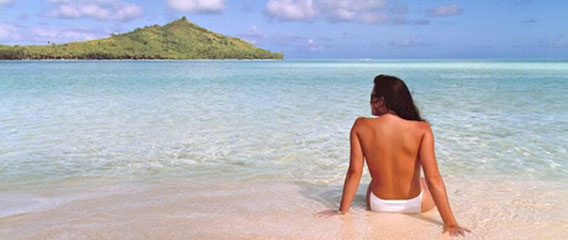Jennifer in paradise: the story of the first Photoshopped image
One holiday snap has been manipulated thousands of times on thousands of computers. Here’s how a woman on a beach in Bora Bora taught the whole world to tinker with pictures
It hardly looks like an image that shook the world. But this photograph, taken in 1987 by John Knoll, could be as central to the modern visual vernacular as Eadweard Muybridge’s shots of galloping horses or the first use of perspective. Its subject is Knoll’s then-girlfriend Jennifer, topless on the beach in Bora Bora, gazing out at To’opua island. The young couple worked together at Industrial Light & Magic, Lucasfilm’s special-effects company, and were enjoying some well-earned R&R after working 70-hour weeks on the film Who Framed Roger Rabbit. Looking back, Jennifer says: “It was a truly magical time for us. My husband actually proposed to me later on in the day, probably just after that photo.” Little wonder that John would name the photo Jennifer in Paradise.
Jennifer in Paradise.tif – the picture Photoshop co-creator John Knoll took of his future wife Jennifer in Bora Bora. Photograph: John Knoll
But the image was to become much more than a record of a perfect moment. At ILM, Knoll had encountered a cutting-edge piece of hardware known as the Pixar Image Computer, one of the first that could be used to manipulate images. “I thought it was amazing,” he says. “The fact that you could take an image from film, scan it in and turn it into digits and then manipulate those numbers and put it back
out on to piece of film – it meant that there was literally no limit to what you could
 do to it in the middle.” The Pixar machine cost hundreds of thousands of dollars and
do to it in the middle.” The Pixar machine cost hundreds of thousands of dollars and
the image-processing software was so complex it required a specially trained operator. So Knoll was somewhat taken aback when he visited his brother Thomas, who was reading for a doctorate in computer vision at the University of Michigan, and discovered that he’d developed some similar software that could run on a much cheaper Macintosh Plus. Knoll began to chivvy his brother into pushing the application further. “It was really just a hobby at first,” he says, “but I kept asking him to add more features.”
Eventually they had something that John believed they could sell. The only problem was, with so few digital images available at the time, it was hard to demonstrate what their new application could do. Visiting friends at Apple’s Advanced Technology Group lab, Knoll took the opportunity to use one of their flatbed scanners, also rare devices then. The only picture he had to hand was that 6in x 4in print of his wife in Tahiti.
In this way, Jennifer in Paradise became the first colour image used to demonstrate the software they had started to call Photoshop.
“It was a good image to do demos with,” Knoll recalls. “It was pleasing to look at and there were a whole bunch of things you could do with that image technically.” And maybe there was something in it that hinted at the kind of more perfect world that Photoshop might reveal. Knoll would leave a copy of the software in a package including the picture at the companies he’d visited. Often he’d return to find that the programmers had cloned his wife.
See the rest of the story here (via The Guardian)

© 2014 Copyright ShootTheCenterfold.com. All rights reserved.





















